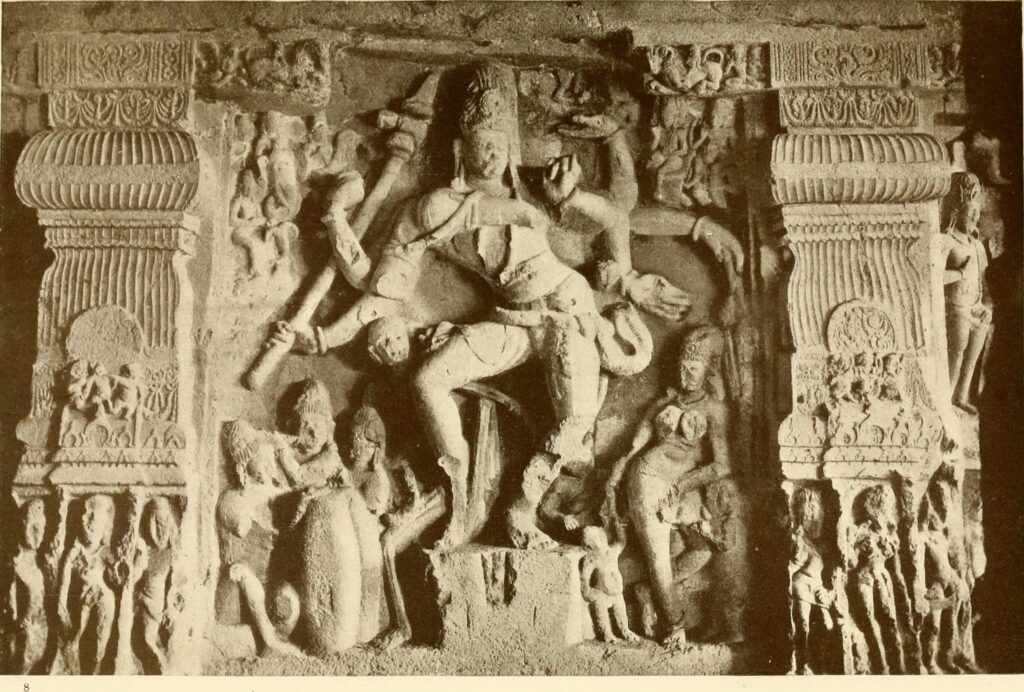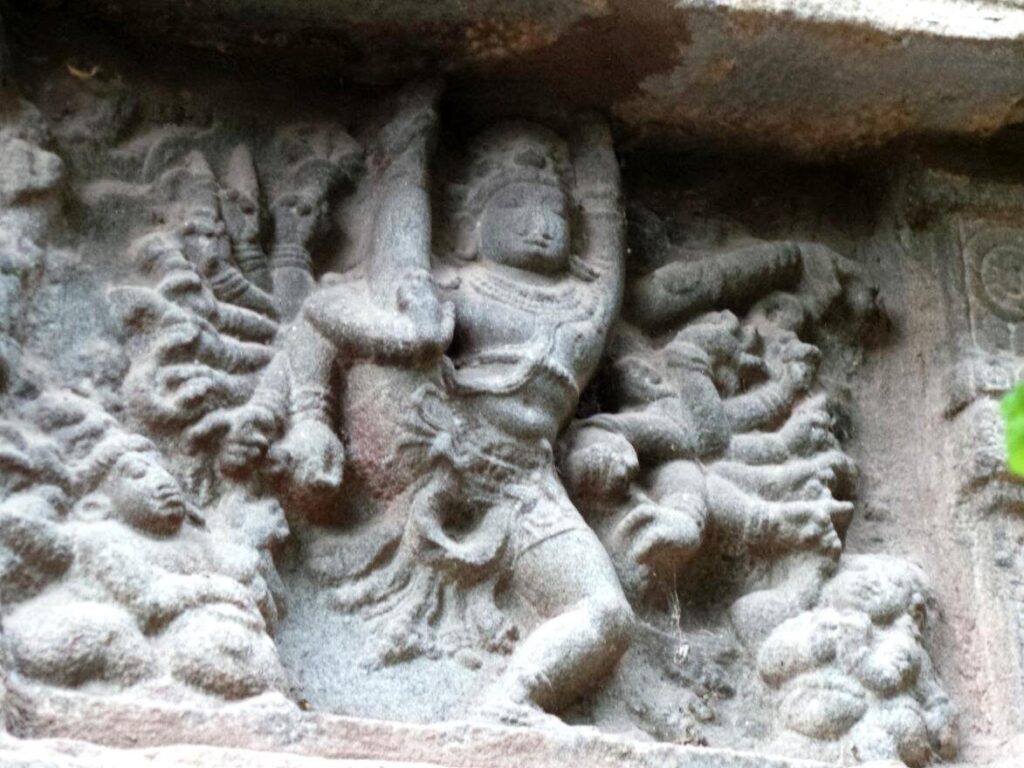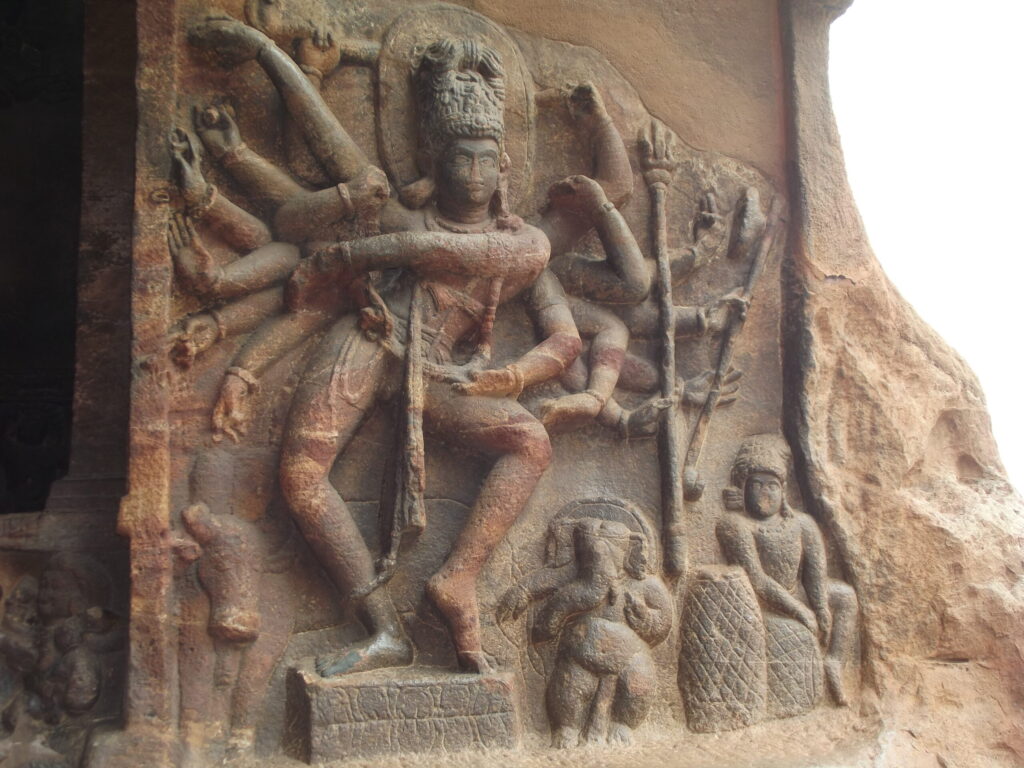In the Thillai court, he dances, a dance so divine, in a form so splendid……
How can one visualize that splendid form, in fact , how to give a form to the formless One, the one who is both the absolute and the infinite. This question has caught the interest of many, and he answered their questions through art, an art so splendid as him, so divine as him, and an art which froze the formless One into a form, and showed the Master of Dance in his best self, as the cosmic dancer. It is no exaggeration when it is said that the Dance God has been the favorite of many of a sculptor and he has been visualized in beautiful forms of dance carved into stone.
So how does the formless One look, what does he carry, what does he symbolize through his various forms, all these answered in the iconography studies of the dancing God, which is an elaborative, but interesting study. The sculpture and iconographic studies mention various forms like the Anugraha murti, the Dakshina Murti, the Kalantaka Murti, the Kalari Murti, to name a few. What attracts me being a dancer is the Nrittamurti form of Shiva, which is the most vivid, beautiful and intricate form of sculpture as it depicts two visual art forms of dance and sculpture.
I must not forget to mention the innumerable important descriptions of the Nritta Murtis mentioned in our literature, especially when it comes to Nritta and Silpa, very importantly, the Agamas and the Sastras. Texts like the Silpa Sastra, Silpa Ratnakara, Silpaprakasika, the Agamas like Amsumadbhedagama not forgetting the Puranas like the Matsya Purana, the Vishnudharmottara Purana, the Kurma Purana and many more more mentioning in detail about the dancing forms of Shiva. Not only these, his dance has been envisioned in the sacred chants , hymns, poetry and sacred mantras of the time too. However, with a little of my humble knowledge, I would like to share few interesting aspects of the Nritta murtis of Shiva taking references from few of the iconography literature and the dance definitions according to the Natya Sastra, trying to relate them to the beautiful visual representations found in our temples, this is do, while I reminisce in mind the slokam from Natya Sastra, “Sarva Silpa pravartakam, Natyakhyam Panchamam vedam…”
NATARAJA MURTI

It starts with the prominent and well known one, the iconic Nataraja.
Nataraja, as an icon of dance is the most celebrated and the popular iconographic forms of Shiva. The Chidambaram temple where Shiva is worshipped in his dancing form of Nataraja depicts his nature of how he is the balance of the universe, and this he does through the depiction of his posture, his hastas and the iconography, each which depicts a special feature, element and meaning of life.
The Silpa Ratna mentions the iconography of the dancing form of Shiva in nine varieties. The first variety, which is the well-known, is that of the Nataraja Murti. Shiva is seen in the Bhujangatrasita karanam (the left leg stretched across towards the right side in Dola Pada sway of the foot, and the right foot in normal- Sama position ) on the Apasmara Purusha. He has four hands, the first in Abhaya, and the other in Gaja hasta, (stretched across the body). In the second set, he holds Agni in a bowl and the Damaru in the other. The forehand of Abhaya is entwined by a snake and there are snakes scattered all around on his body, and his hair locks wide spread. He wears a skull headed crown attached to which is the crescent moon. He adorns the Rudraksh beads on his body. Goddess Parvathi stands to his left witnessing his blissful dance.
Although the Amsumadbhedagama mentions a similar type, here he holds the fire in his hands, instead of a bowl and he is encircled with the Prabhamandala, the circle of fire, which is the representation of time, the Kala Chakra, shining with the 27 Nakshatras, are the symbols of the cosmic movement of the universe in accordance to the time cycle. He wears a Patra Kundala on the left side, representing the feminine, and the Makara kundala on the right ear, symbolizing masculine. The Agama also mentions Parvathi beside Nataraja, with Skanda in her arms. But, there has been a wide variety added to this and one cannot help, but comprehend that the sculptors have taken creative liberties to sometimes carve Devi in various graceful forms accompanying Nataraja, and indeed each form of her, is a sight to behold. The significance of Nataraja is huge, and the prime trait to understand Shiva as a dancer. From this forms do the rest of the forms emerge.
While the Chidambaram Nataraja temple built by the Cholas answers all about the iconography of Nataraja, we do have very beautiful examples of Pallava architecture mentioning the pose of Nataraja. The Sivamangalam temple of the early 7th century in the Pallava period has a beautiful sculpture of Nataraja as mentioned in the Bhujangatrasita Karanam of the Natya Sastra and the Amsumadbhedaagama. However, the Apsmara Purusha is missing here. There is another Nataraja Murti at the Mahabalipuram with the Apsamara Purusha. And then there are innumerable Nataraja Murti iconography coming down the timeline of sculpture, all of them having the same importance.
Another interesting sculpture of this Nataraja form is that of Shiva dancing with the reversed leg , the right leg raised ( instead of the regular left foot raised) from the early Pandyan period (10 th century), in Madurai. This is seen in the Rajata Sabha (the Silver Dancing Hall) one of the Pancha Sabhas where Nataraja danced. The same sculpture is also in the Shaankari Devi temple in Sri Lanka, which is also one of the Shakti Peetha of Goddess Parvathi.
Why the reverse leg was a question often pondered by me, and I got an answer to that, in a temple tale of Madurai. Madurai was ruled by Rajasekhara Pandya during in the 11- 12th century, who was an ardent devotee of Shiva. A great connoisseur of arts, the king himself had mastery in all the Chatushasti Kala, the 64 arts. But, after learning dance, he understood how much of effort and pain it goes into the body to master it into an art form of skill and grace. His thoughts immediately went to Nataraja in the temple of Madurai. He rushed to the temple and requested Shiva to change the stance of his leg, as standing on the same foot for so long would be so painful all this time. Pleased and filled with love for his devotee, Shiva changes his stance from the left to the right foot raised, as if to give his foot some rest on the pleading of his devotee. Even today, this story echoes in the Natya Mantapa of Madurai where Shiva is seen in the reversed leg posture of dance.
LALITA MURTI

Another mode of the universal dancer is the Lalita Murti. The Natya Sastra describes the Lalita posture with the left arm pose in the Gaja hasta and the right in the Parivartita hasta ( different movements of the hand) the feet in the Kunchitam and the Sama position. Although the name suggests grace, it is one of his energetic dance form.
There are exemplary stone carvings of the Lalita Murti in the Ellora caves. Shiva is seen dancing energetically, with his Kati (waist) raised to one side and the other side bent low. The foot stance is in Kuncita and Sama as required for the Lalitam pose. Although the hands are mutilated, one can identify the Damaru, Parasu , the Trripataka hasta near the ear, Suchi hasta (index finger). To the left of Shiva, stands Parvathi, carrying Skanda in her arms as if asking him to witness the glorified and graceful dance of Shiva, just as the Amsumadbhedagama suggests. To the right of Shiva, are two Ganas playing the drum and the flute, there is another gana statue is seen mutilated. There is also a figure of Kali dancing along with Shiva on the seat on which Shiva is dancing.
LALATA TILAKA MURTI

Then, there is the Lalata Tilakam dancing form of Shiva, one of the astonishing dance forms of Shiva. As the name suggests, this vibrant posture is where Shiva touches his Lalata (forehead) with his right leg ( totally lifted up) as if he marks a Tilaka on the forehead. The Amsumadbhedagama and the other Silpa Sastras mention Shiva in the Lalita Tilaka dance as the one who has his right leg lifted to the similar posture of a karana of Natya Sastra, the Vrschika Karana , wherein the leg is raised up like the tail of a scorpion, (hence the name Vrschika) and the left leg on the Apasmara Purusha, however sometimes it can be seen that the posture is also seen in the Nishumbita ( leg lifted from behind and bought onto the forehead) and the Vidyutbhranta karanas ( leg raised higher than the vrschika karana)too. With the right hand, he holds the pataka or the abhaya mudra and the left has him holding a kapala. Shiva is accompanied by Bhairava dancing in the Lalita posture and Nandi playing the drum.
This form of Shiva is seen in the Madurai temple on the way to the pathway to the inner sanctum of Meenakshi Amman, and also in the upper façade of the Kamba Mantapa of the Chidambaram temple. Also, this form of Shiva is seen in the Shiva temple at Tiruchchengattangudi, which is one of the very popular and prominent sculptures depicting the Lalata Tilaka form of the Nriitamurti.
Another interesting sculpture of the Lalata Tilakam form of Shiva can be seen in the Sarangapani temple at Kumbhakonam, Tamil Nadu. The sculpture is in a sense, an aerial movement where it looks like Shiva while raising his right foot to touch his forehead, is ready to jump in the air. The multi armed Shiva with eighteen arms, shows a three -fold aspect here in this sculpture. Shiva holds the Gnana (Samdamsa hasta according to the Natya Sastra) mudra for knowledge, the Abhaya mudra as a life giver and the Tarjani mudra (index finger) suggesting that everything which is born , perishes, and that is the fact, and let the mind have knowledge of this”. In one of the other hand, he holds the Gaja hasta pointing to the foot on the ground, which means that there is liberation at his feet, and then another uplifted hand shows Moksha, the soul travels upwards towards him, merging in him.
Another prominent figure of this dancing form is found in the Kailasanatha temple at Kanchipuram. Here, Shiva has eight arms and he carries various objects like the Trisula, Valaya and the Dhwaja. He holds the Pataka or the Abhaya hasta in the right hand. The variation is seen wherein the right foot which is raised from the behind of the body to the forehead like in the Nishumbhita Karanam. Shiva is accompanied by Nandi dancing to his side and other celestials like the Kinnaras playing on the Vina. Adjoining Shiva are the figures of Vishnu and Brahma watching his vibrant dance.
CATURAM

Shiva balances the twin aspects of dance, the tandava and the laasya. The energetic, and the graceful. While the Lalitam and the Lalata tilakam form display his energetic form, the Caturam form represents his graceful side. The Natya Sastra defines Catura karana to be performed with hands in the Ancita and the Catura hastas and the right leg in the Kuncita ( toes touching the ground) stance, while the left foot rests in Sama.
The Badami caves have beautiful representation of the Catura Nritta murti. Probably, this figure of Shiva is one of the most popular and known sculpture which represents Badami’s beauty in a single sculpture. Shiva is seen with sixteen arms carrying various objects. And he stands in the Caturam posture as defined in the Natya Sastra. Beside Shiva, stands Nandi his vehicle and on his left is seen Ganesha accompanying Shiva on the Mrdangam. There are two other Ganas dancing seen in the panel also. This Caturam from can be noticed in the Nava Brahma temples of Alampur. Dedicated to Shiva, the temples are of all, but carvings of Shiva in different forms. An intricate carving on the roof panel, leading from the main pathway to the main temple sanctum has the Caturam form of Shiva, accompanied by the Navagrahas, representing him as the head of the Navagrahas.
Another beautiful example of the Caturam dance form of Shiva can be seen from the Vakata period carved in cave 22of Ellora. Although slightly mutilated, it is yet a beautiful masterpiece of art of Shiva in the graceful stance of Caturam. Another striking feature of this sculpture is the hoard of musicians accompanying Shiva with a wide variety of musical accompaniments like the vina, flute, the mrdangam and the cymblas. Parvathi is seen with Skanda in her arms as if telling her son to watch how graceful his father is , as a dancer. A similar, but simpler version of the Caturam form of Shiva is found in the Cave 16, of Ellora, belonging to the Rashtrakuta period.
TALASAMPHOTTITA FORM

According to Sculptural iconography, The Talasamphottita mode of dance is another form of the Nritta Murti. As the name gives an energetic vibe and suggests action, , it is an dynamic mode, wherein Shiva is seen stamping the ground with one foot and the other of his feet lifted high up., and then he lands on the Kuncita stance of dance, or sits on the ground with one knee bent and the other raised up touching his back, like the scorpion’s tail. The Natya sastra suggests that this is an act of thumping the ground, and hence named Samsphottita (to thump, hit). Shiva has the Abhaya and the Varada hastas, and in others he has various objects. The iconography also suggests Ganga on his forehead which is different and diverse from other forms.
One such representation can be seen in the Kailasanath temple of Kanjivaram with an addition of Ganga carved in his locks in the Anjali hasta in a standing position. Parvathi is seen to his left side. The same representation is seen in the same temple, in the variation of a seated position and instead of the Abhaya hasta, Shiva is seen raising his hand to the top.
Apart from these forms, Shiva is seen as the Ardhanariswara form, the Dakshinamurthi Murti, the Kalarimurti from all which have suggestive dance postures. In fact, the Saivagamas mention that Shiva danced in 108 forms, all which refer to the 108 karanas as mentioned in the Natya Sastra. Sculpture is a varied art, and I can only understand and feel the creativity of the sculptors in carving the God of dance in both energetic and subtle forms but I fail to express that momentum, as words are not enough to describe the energy and beauty of these Nritta Murtis. A hymn comes to my mind, which I remember reading in the renowned writer and researcher David Smiths’ book, The Dance of Shiva,
Him, who is the First
Who has Moon his crown
Whose foot is bent
I worship
And humble salutations are what I offer to the Infinite form, The One form.
